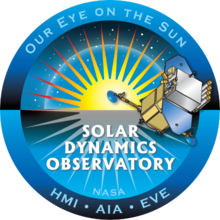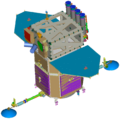Solar Dynamics Observatory
| SDO | |
|---|---|

|
|
| Type: | Solar research satellite |
| Country: |
|
| Operator: |
|
| COSPAR-ID : | 2010-005A |
| Mission dates | |
| Dimensions: | 3100 kg |
| Size: | 2.22 m × 2.22 m × 4.50 m |
| Begin: | February 11, 2010, 3:23 pm UTC |
| Starting place: | Cape Canaveral , LC-41 |
| Launcher: | Atlas V (411) |
| Flight duration: | 5–10 years (planned) |
| Status: | in orbit, active |
| Orbit data | |
| Rotation time : | approx. 24 h |
| Track height: | 34,600 km |
| Orbit inclination : | 28.5 ° |
The Solar Dynamics Observatory (SDO) is a NASA mission launched on February 11, 2010 to study the dynamic processes of the sun , which is being developed under the Living With a Star (LWS) program . SDO will continue the measurements of the SOHO probe . The cost, including the first 5 years of the mission, is approximately $ 856 million.
Start and mission duration
The SDO satellite was built at NASA's Goddard Space Flight Center . The start date of the SDO could be brought forward due to the postponement of the MSL from the 2009 to the 2011 Mars start window, as the SDO was able to take over the position of the MSL in the start calendar for 2009. The launch was originally scheduled for February 10, 2010, but was postponed by 24 hours due to strong winds.
The launch took place on February 11, 2010 at 10:23 a.m. (local time).
An Atlas-V was used as a launch vehicle , which transported the satellite from Cape Canaveral into a geostationary transfer orbit . From there, SDO maneuvered itself through eleven thrust maneuvers into a geosynchronous orbit with an orbit inclination of 28.5 °, which it reached on March 16, 2010 with the help of its own engine . The mission has a minimum duration of five years and three months, but enough fuel is carried for a ten-year mission.
The first light recordings were released on April 21, 2010 .
construction
SDO is a three-axis stabilized satellite measuring 2.2 × 2.2 × 4.5 m³, which as a whole is aimed directly at the sun using instruments and solar panels . It has an apogee thruster for injection into geosynchronous orbit, as well as various small attitude control thrusters. The launch mass is 3100 kg, of which 1400 kg is accounted for by the fuel carried and 270 kg by the scientific payload. The solar panels with an area of 6.6 m² and a span of 6.5 m produce 1450 watts of power.
Scientific instrumentation
SDO has the following three instruments on board:
- Extreme Ultraviolet Variability Experiment (EVE): TheEVE developedby the Laboratory for Atmospheric and Space Physics is used to measure solar extreme ultraviolet radiation (EUV) in the range of 0.1-105 nm with a previously unattained accuracy of the spectral resolution (better than 0 , 1 nm) with simultaneous high temporal resolution (one image every 10 s).
- Helioseismic and Magnetic Imager (HMI): TheHelioseismic and Magnetic Imager (HMI) developedby Stanford University enables measurements of solar variability as well as various components of solar magnetic activity.
- Atmospheric Imaging Assembly (AIA): The Atmospheric Imaging Assembly (AIA) developed by the Lockheed Martin Solar and Astrophysics Laboratory enables images of the full solar disk in nine different wavelength ranges in the ultraviolet (UV) and extreme ultraviolet (EUV) frequency range, as well as one in the visible range with high temporal and spatial resolution. The AIA, equipped with four cameras, takes a picture in HDTV resolution every 10 seconds in eight of the ten frequency ranges and a resolution of 725 km.
communication
SDO will transmit the measured scientific data over a high-speed radio link with 130 megabits per second in the Ka-band at 26 GHz, for which the satellite has two antennas. Operating data are transmitted via S-band . A ground station specially built for the SDO mission on the White Sands Missile Range with two redundant 18-meter antennas will receive the data. The data stream will be up to 300 Mbit / s , the average amount of data recorded daily will be around 1.5 terabytes .
See also
Web links
- SDO mission website
- SDO's website at NASA
- Three Years of Sun in Three Minutes, 3:57 minutes
- SDOs official flickr photo stream
- Extreme Ultraviolet Variability Experiment (EVE)
- Helioseismic and Magnetic Imager (HMI)
- Atmospheric Imaging Assembly (AIA)
- SDO Fact Sheet (PDF; 3.3 MB)
- SDO Guide (PDF; 14.1 MB)
- SDO Press Kit (PDF; 877 kB)
Individual evidence
- ^ Richard A. Lovett: First light for Solar Dynamics Observatory. In: Nature . July 24, 2010, accessed April 26, 2012 .
- ↑ Stephen Clark: Solar spacecraft inherits a new launch opportunity. Spaceflight Now, December 19, 2008, accessed December 23, 2013 .
- ↑ NASA's Shuttle and Rocket Launch Schedule. NASA, accessed January 10, 2010 .
- ^ Solar Dynamics Observatory sdo.gsfc.nasa.gov (accessed February 10, 2010)
- ^ Mission Status Center. Spaceflight Now, accessed April 7, 2010 .
- ↑ Nasa's Solar Dynamics Observatory returns first images BBC News, April 21, 2010; SDO First Light NASA, April 21, 2010, (access = April 22, 2010)
- ↑ SDO Press Kit. (PDF) NASA, January 2010, p. 6 , accessed on December 23, 2013 (English).





